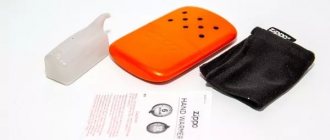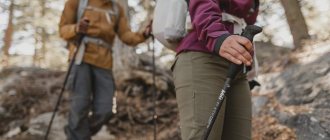During the hike, your feet will become wet more than once; this is absolutely normal in such conditions. You stepped into a puddle, or you need to dry after rain, or in some other situation - it’s an everyday matter. But it’s still not worth leaving this unattended. Having reached the rest stop, you need to dry your wet shoes. Calluses immediately rub on your feet in wet shoes, and moisture is an excellent breeding ground for bacteria. In addition, there is a risk of hypothermia. Therefore, drying your boots while hiking is mandatory.
Socks or towel
To dry the inside of your shoes, you can use socks or a microfiber towel. To do this, put dry socks on your feet and put on your shoes. After some time, wring out the socks and repeat the procedure. It will be very good if you find the opportunity to dry your socks by the fire. But be careful - there is a risk of getting burned and frying your socks to a crisp.
Thermal socks art.307 AVI-Outdoor 297 for 1 pair. Thermal socks AVI-outdoor art.946 AVI-Outdoor 480 for 1 pair. Thermal socks art.979 AVI-Outdoor 470 for 1 pair. Thermal socks pattern - rectangle art. 509 AVI-Outdoor 420 for 1 pair. Socks K2 MUND 1,690 for 1 pair. Trail Running socks MUND 790 for 1 pair.
-40%
Thermal socks (51-0513) GUAHOO 535 321 for 1 pair.
-50%
Thermal socks (52-0583) Outdoor GUAHOO 835 417.50 for 1 pair. Hunting Caza socks MUND 970 for 1 pair. City Casual Winter socks MUND 1,000 for 1 pair.
Buy comfortable socks for hiking
If you have a microfiber towel, simply roll it up and put it in your wet shoes, then wring it out, dry it and repeat the procedure. These towels dry quickly, but along with moisture they can also absorb unpleasant odors, so use something you don't mind.
Drying by the fire
Let’s say right away that this is the most dangerous drying method. And not only because there is a risk of getting burned. There is a risk of ruining your shoes completely and irrevocably, even if they are very expensive and of high quality. Almost all shoes contain synthetic fibers, and at high temperatures - and you are unlikely to be able to measure them accurately - they will simply shrink a couple of sizes and become greatly deformed. This is the best case scenario. At worst, it will simply melt. Therefore, be extremely careful and attentive when drying your shoes by the fire.
How to dry your shoes while hiking
One of the most unpleasant things that can happen to you on a hike is getting your boots wet. The situation is extremely unpleasant, but solvable. To reduce the likelihood of your boots getting wet, your trekking shoes need to be properly prepared for the hike. But, if such a disaster happens and the weather permits, the safest and most reliable way to dry your boots is to leave them in the sun. Sun drying
has a number of advantages: – shoes are not deformed; – surface and membrane materials do not lose their properties; – the shoes will not lose their original appearance.
If there is no time to dry shoes in the sun, then many tourists dry them on themselves
. In sunny weather, this drying method usually takes 3-4 hours.
A more or less gentle way to dry boots is to pour hot sand or small stones into the sock
and insert it into the shoe. Stones can be heated by placing them very close to the fire. Two points are important here: do not overdo it with the temperature of the filler in the socks, otherwise you can damage the membrane in the boots or even the surface of the boots, and also monitor the cooling of the filler and regularly change it to a hotter one.
If the campsite is located close to civilization, then a very good way to dry boots is using glass bottles
(when the base camp is located at an altitude of 2200 m and far from populated areas, it is not rational to carry excess weight in the form of a kilogram of glass in a backpack). You need to pour hot water into a bottle and insert it into the shoe. But, as in the previous method, it is important to monitor the temperature here so as not to damage the shoes.
As a variant of the above method, you can heat a flat stone near a fire
and put boots on it.
But, despite all of the above, the most popular method among tourists remains the method of drying boots by the fire
.
Personal experience shows that in the middle of a hike you can be left, at best, without insoles, and at worst, without shoes at all. But if you still decide to dry your shoes by the fire, you must follow a few simple rules:
– most importantly, do not leave your shoes unattended! It only takes a few minutes for the sole to melt or the boot itself to smoke. – the most effective would be not to place the boots on the stones by the fire, but to hang them on pegs that need to be driven into the ground slightly away from the fire or simply held in your hands at a distance from the fire that is comfortable for your hands.
Disadvantages of drying shoes by the fire
a lot. The most important thing is that your expensive pair of shoes can be hopelessly ruined. Firstly, the shoes will be saturated with the smell of smoke, which does not disappear from the inside of the shoe, which, together with the natural smell of foot sweat, creates a unique “aroma”. Secondly, due to unregulated thermal effects, the properties of the surface materials of shoes are lost - waterproofness, vapor permeability, wear resistance. In addition to this, the shoes are greatly deformed, and after such drying you risk getting shoes that are a size or two smaller. Thirdly, sparks flying from a fire can burn your shoes or, at best, simply leave an unsightly scorched mark.
Recommendations:
– for effective drying of shoes, the insoles must be pulled out and the laces loosened as much as possible. – At night, pack your boots in a plastic bag and put them inside the tent. This prevents your shoes from being exposed to moisture during the night.
After the hike:
– wash shoes; – dry thoroughly; – if damage appears on the shoes, try to eliminate them immediately; – insert crumpled paper into the shoes so that they do not become deformed during storage.
Drying in the sun or wind
The method works, but only in appropriate weather. Unlace your shoes, remove the insoles and place them in a well-ventilated, sunny place.
We dry the boots on our feet. This method is applicable only in the warm season in active approaches. First, drain all the water from your shoes, squeeze out the insoles and edges of the shoes as much as possible without deforming them. After that, put on your shoes and do any activity. A heated body will play the role of a battery or shoe dryer. During this drying process, you will experience some discomfort, so this method is not suitable for everyone. Fortunately, he is far from the only one.
Boots CRUX (72053-350) SCARPA 10,300 for 1 pair.
-20%
Men's boots Pelmo Lomer for 1 pair. Boots ZODIAC PLUS GTX SCARPA 22,072 for 1 pair. Boots MARS BOA 08 women's CHIRUCA 7,600 for 1 pair. Low shoes (10003V103) unisex GRISPORT 7,195 for 1 pair. Boots MISTRAL KID GTX SCARPA 8,100 for 1 pair. Boots KAILASH TREK GTX WMN (61056-202) SCARPA 16,600 for 1 pair.
-30%
Boots R-EVOLUTION GTX WMN (60266-202) SCARPA 17,500 12,250 for 1 pair. Boots SCOUT (13992) Norfin 7,100 for 1 pair.
Buy reliable trekking boots
Drying shoes with stones
We collect small stones, fill them into a tin can or kettle and heat them over a fire, but not to the point of cracking. This is how we warm it up normally. After that we place them inside the shoe. It is better to first put them in a sock or wrap them in a dry towel so as not to stain the shoes and so that they heat up more evenly and no synthetic element melts. This is one of the best ways to dry shoes in 40-60 minutes, but for boots with a thin synthetic lining or membrane, use this method carefully, as hot stones can quickly melt the synthetic material. In this case, it is better to heat them very moderately.
Stones
This method requires a lot of small stones. They are placed in a pot or tin can and heated over a fire. Having warmed the stones well (not to white heat!), pour them into the shoes. You can pre-wrap them with a scarf/towel/sock so as not to stain the shoes from the inside. Periodically, the stones need to be shaken so that the shoes are heated as evenly as possible.
This method allows you to dry even thoroughly wet boots in 20-60 minutes, although it requires care. It is not recommended to use this drying method for shoes with a thin synthetic lining and membrane, as hot stones can easily melt them.
Drying with paper
An old, but working method - paper absorbs moisture perfectly, so we crumple newspapers or other pieces of paper and stuff our trekking boots with them. This life hack has a significant disadvantage - you will also have to carry paper with you. Yes, it weighs no more than half a kilogram, but on a long hike every gram counts, especially if the route goes through rough terrain. By the way, just a note - if you don’t have paper with you, you can use improvised, or rather, pasture materials that have absorption - dry leaves, moss or grass. Yes, then you will have to carefully clean your shoes from small debris, but this is less evil than wet shoes and bloody feet.
Salt warmers and thermoids
These useful things were invented specifically for tourists - you can hold them in your hands without fear of getting burned, and warm any part of the body. Due to its compactness, every tourist will have at least one thermal fluid or heating pad. What is it and how does it work? A thermoid is a small, depending on the model, plastic bag filled with a special compound. After opening, a reaction with oxygen begins and the thermal fluid begins to heat up significantly. Heat release occurs from several minutes to several hours - it depends on the active substance and size. All thermal fluids sold in stores today are disposable and cannot be reused.
Warmer Theploid disposable Woodland 3 h 40 for 1 pc. Warmer Theploid disposable Woodland 10 h 70 for 1 pc. Warmer Theploid disposable Woodland 6 h 46 for 1 pc.
A salt heating pad is a silicone bag of liquid with a metal element floating inside. To start the heating pad, simply bend this element in your hands, after which the solution will begin to crystallize, releasing a large amount of heat. The main feature of salt warmers is their reusability. To return the heating pad to its original state, after complete crystallization, it is necessary to place it in boiling water for 10 minutes, after which it will again become suitable for use. Just put a heating pad or thermal fluid in your boots and wait, it’s as easy as shelling pears.
Drying boots with thermal fluids and salt warmers
Thermoids and salt heating pads are commonly used to warm hands or add heat to a tent. But they are also suitable for drying boots. You can also use ordinary products, but if you are going to dry your shoes, it is better to purchase a special heating pad in the shape of a shoe insole (Figure 6).
Power heating pads are containers containing a supersaturated salt solution with a small metal element inside. If you bend it a little, the salt will begin to crystallize and generate heat. After heating, just put the heating pad in boiling water for a few minutes. The crystals will dissolve and the product can be reused.
Figure 6. Theploids and salt heating pads are the most modern methods of drying
Of course, both means can be used to dry shoes. But remember that thermoids are intended for only one use, and a salt heating pad, although a very practical thing, will still take up extra space in your backpack.
Popular methods of drying shoes while traveling are discussed in the video.
Dry with silica gel
Surely many have seen small sealed bags with small stones in each pair of shoes. This is silica gel, which is designed to keep shoes dry during storage and transportation. It can also be used as an adsorbent when drying shoes while hiking. This is not the most popular method, but in vain - it is a cheap material that can be purchased everywhere, and it absorbs moisture very well, with its help you can dry not only shoes, but also other things or equipment. If the shoes are just slightly damp from sweat, then a couple of silica gel packets per shoe will be enough, but if the shoes are wet after rain, then a much larger volume will be required. But silica gel can be used repeatedly.
Important! If, when drying your shoes, you left them out of your sight for even a short time, then before putting on your shoes, be sure to check them for uninvited guests. Various insects, snakes and rodents, which are not very useful for tourists, like to hide in such improvised shelters.
How to dry rubber boots while hiking
Rubber boots have become an indispensable assistant for tourists and mushroom pickers, fishermen and rafters - by taking them on a hike, you can forget about the problem of wet feet.
By protecting your feet from getting wet, rubber boots can become a means of protection against lightning: rubber is an excellent dielectric, non-conducting.
There are, however, annoying cases:
- He was wading across the river and, not calculating the depth, scooped it up with the edge of his boot.
- I stumbled while jumping from hummock to hummock in the swamp and fell into a puddle.
- I left my boots near the tent, not thinking about the overnight rain.
- I just dropped my boots in the water.
Then the problem of emergency drying of boots in wild conditions arises.
Attention! When going on a hike, take care of cloth and flannel insoles, and take a spare set. Don't forget wool socks, even if you bought boots with fleece.











